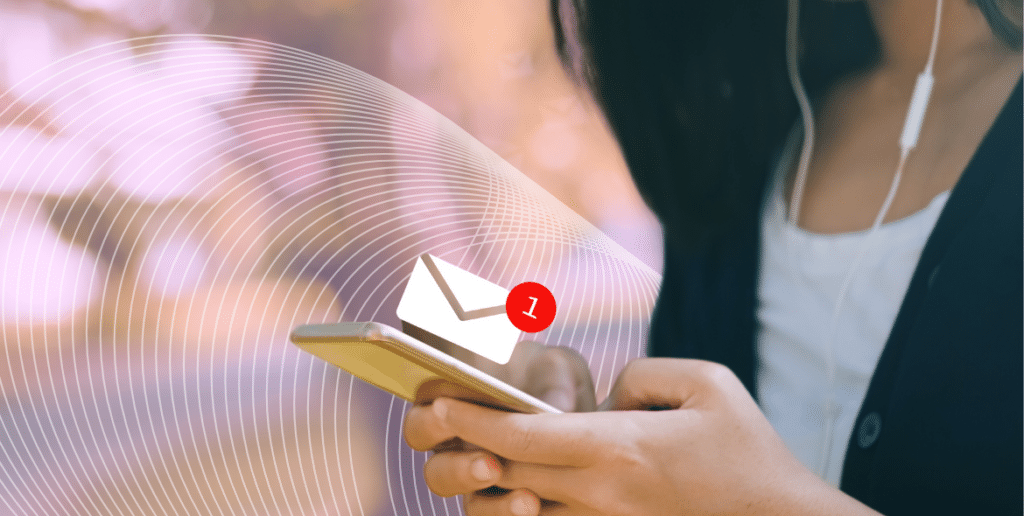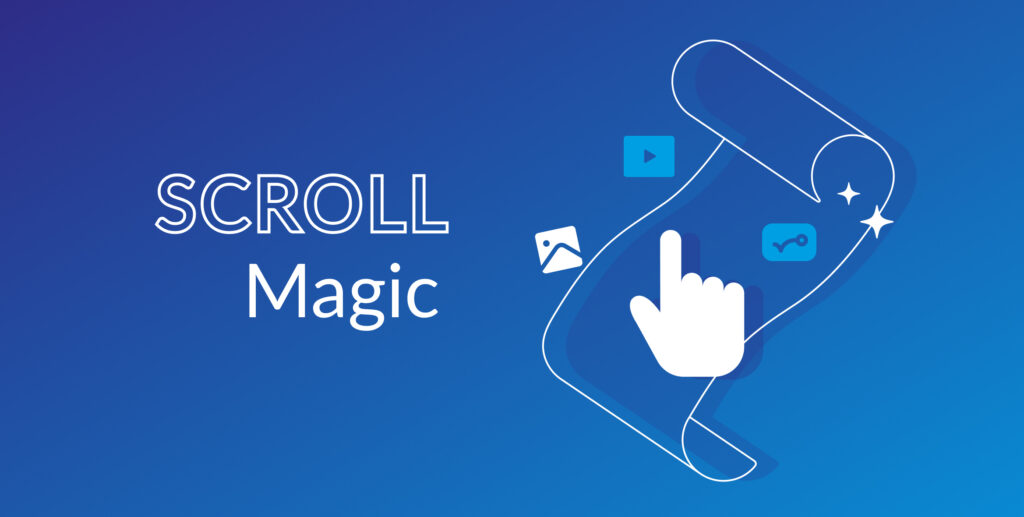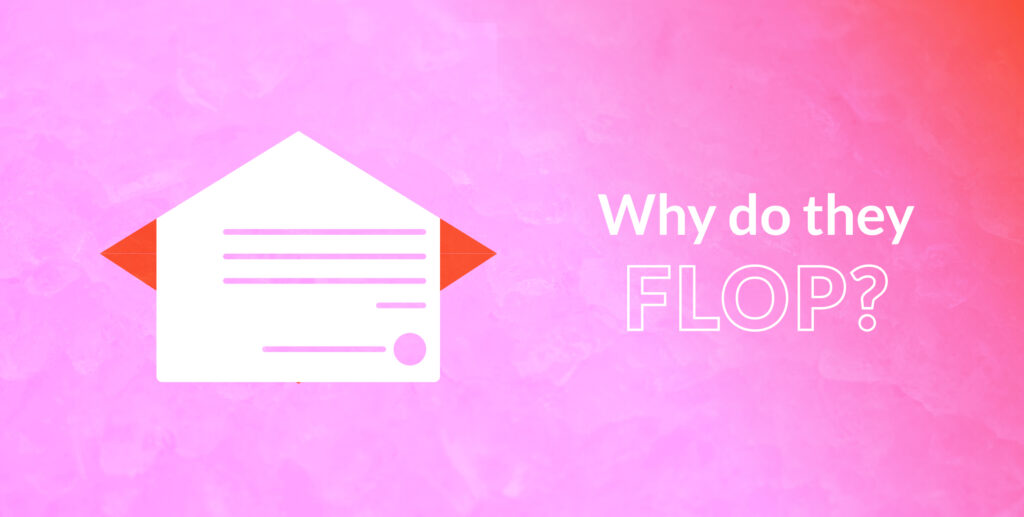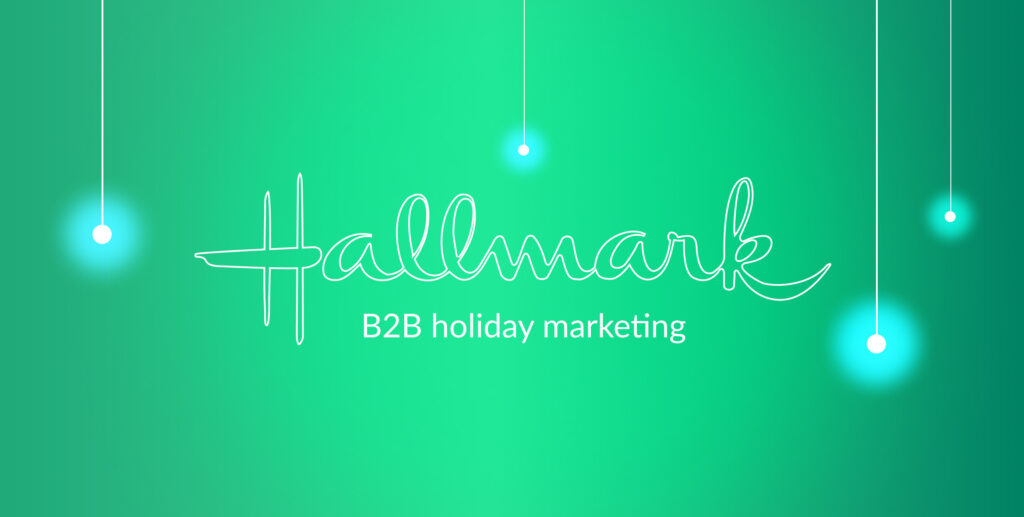You’ve been making all the right noises on social media, but the results aren’t up to your expectations.
Why aren’t the right leads coming in? Why is it so hard for your product and/or service to make a splash?
The answer is very likely to be: you need an email newsletter.
Yes, the humble newsletter, at times branded “uncool,” is a mighty conversion engine.
In this article, find out how to win over the hearts and minds of your customers every time you land in their inbox.
What makes a great B2B newsletter “great”?
We’re all clear on what makes a bad newsletter. Our inboxes are stuffed to the gills with unwanted messages.
It’s no wonder the email newsletter frequently gets labeled “dead”. But for every thinkpiece on the subject, there’s a counter. Hundreds of thousands of folks make money through email lists.
Indeed, email is 40 times better at acquiring new customers than Facebook or Twitter. 59% of buyers say email newsletters influence their decision to buy.
So what makes those B2B newsletters so good, where others fail?
For a newsletter to be fabulous, it has to tick at least one of these boxes:
- Useful. Newsletters providing a service. For instance, recapping news or your top tips on a topic. They’re practical, valuable, and trustworthy.
- Entertaining. Funny or creative newsletters — they make you smile as you open them.
- Inspiring. Newsletters that fill your brain with awe and wonder.
Most types of emails will be a mixture of the three. For example, if you want a mixture of entertaining and useful, you’ll love bytes.dev’s newsletter.
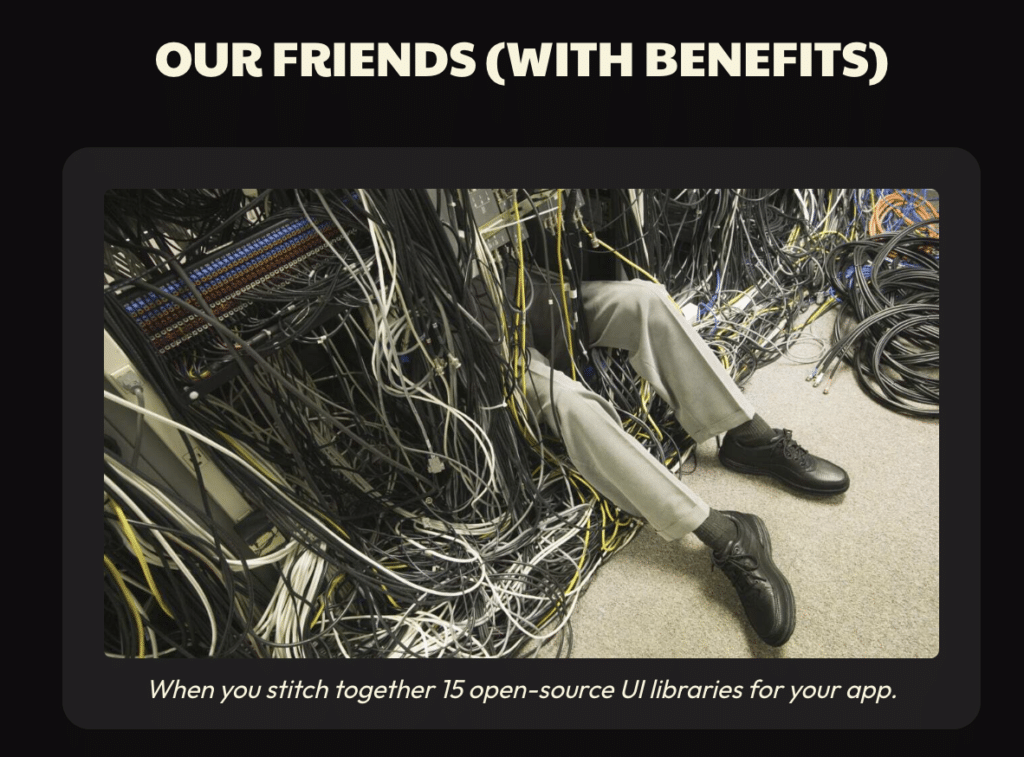
The JavaScript ecosytem might not seem like the most obvious bedfellow of hilarity. And yet, his snarky takes on JavaScript news have over 87,000 devoted fans, two of which you can see below.
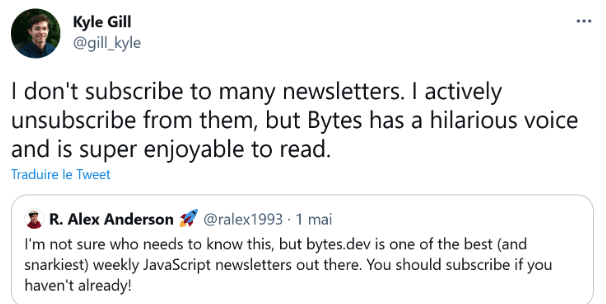
Here’s just a small sample of the type of formats your newsletter could take:
- Long-form first-person emails, with one CTA at the end.
- GIF or meme roundups, or curations of other people’s humor, especially if it can be linked back to your business.
- Newsletters curating things your reader will find beautiful, whether it’s art, nature, etc.
- Cutting-edge news and alerts, so you’re informed before everyone else.
- Tips and tricks, your customers’ most valuable resource.
- Special offers. These are short on text with multiple CTAs.
The list can easily keep going.
There’s one thing all these successful newsletters have in common: they resonate with their target audience.
Everything else is variable: length, colors, images vs. text, number of CTAs, etc.
What will work for one newsletter will flop for another if it’s not right for its audience. Here’s how you can ensure your newsletter is genuinely engaging content.
Find your idea for a B2B newsletter
The best B2B newsletters are consistent. Their readers know what to expect when they open them, even if they don’t know the exact content.
And when that content is what their readers want, the results are phenomenal. 77% of marketers have noticed an increase in email engagement over the last year.
Ideally, your newsletter should sit somewhere between your expertise and what your audience wants.
Ann Handley, master of the newsletter, chose to write as if to one person. “It’s really important for the creator to realise … that there’s one person on the other end and they’ve got to be useful to them,” she says.
But how do you find out what’s useful to one particular person? The right idea doesn’t always pop up immediately.
1. Social listening
If you want unvarnished truths, social listening is the direction to go in. Dip your toes into groups and communities discussing relevant topics. This will give you the insights you need, for example, Reddit can be a ripe source of inspiration for even the most obscure of technologies.
As well as Reddit, there are many other communities where your prospective customers could be hanging out. Check out specialist Slack groups, Facebook groups, Twitter, Clubhouse, etc. And don’t forget about Community boards for apps (such as the Duolingo forum). And yes, this is the case even for B2B, after all, your decision makers are human first, business leaders second.
From your social listening, brainstorm some initial ideas based on the questions you’ve found and discussion topics you’ve encountered.
As well as researching potential customers, don’t neglect the ones that already know and love you. Their opinion should be an important part of your decision process.
2. Ask your existing customers
The internet is a goldmine for ideas and information, but so are your existing customers.
Look back at your interactions with them, and ask yourself:
- What questions frequently come up?
- Which products or services seem to be particularly popular?
Again, make a list of ideas and add it with the list you generated when social listening. Is there an overlap?
To make sense of all these ideas, you’ll need a system, and that’s where a matrix comes in handy. To use the matrix, you need to organize your ideas into one of two categories:
Passion. How excited are you about the topic? Could you happily write about it week after week? Is there enough mileage in the idea to last?
Business potential. Will this B2B newsletter topic help you generate leads and position your company as a thought leader?
For example, here are a few ideas mapped out in the matrix.
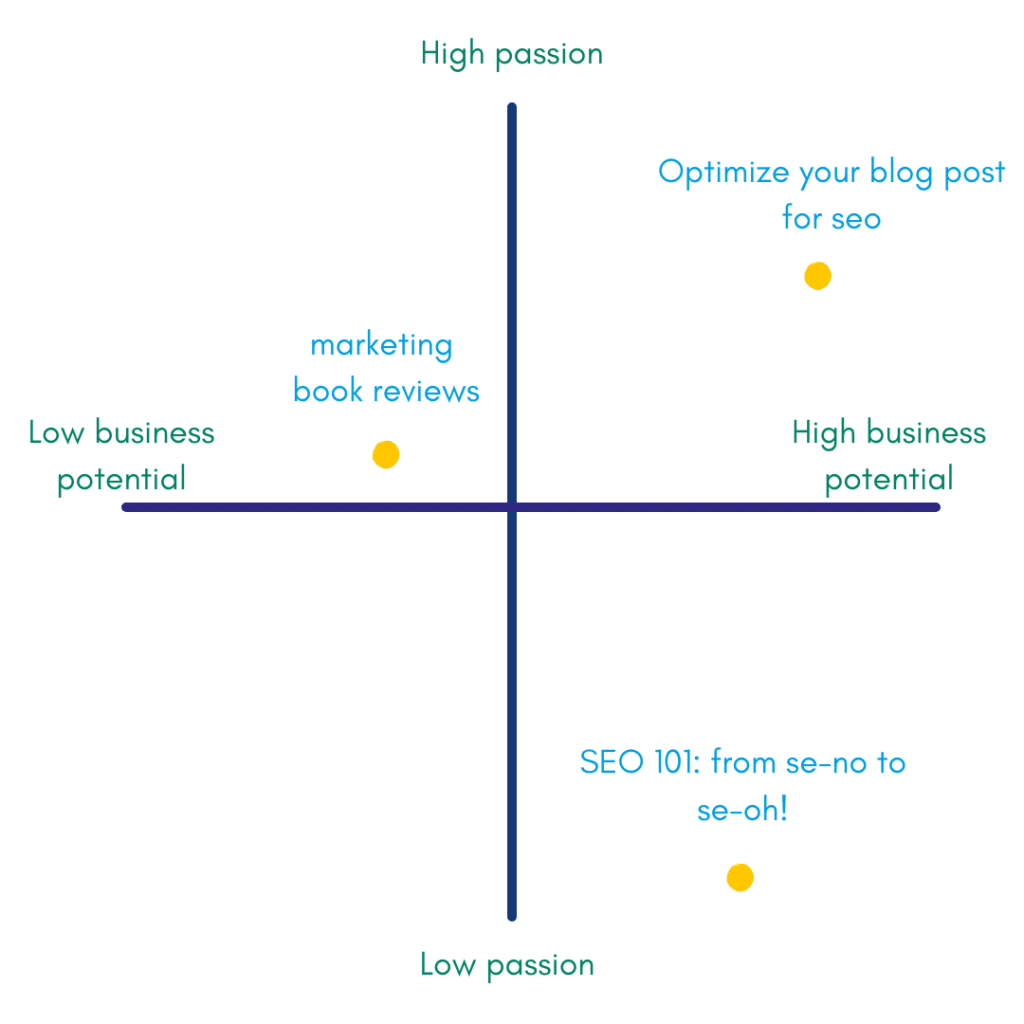
Your winning idea should be in the top right quadrant, as it’ll be the right balance between profit and passion. In this case, it’d be “Book advice applied to SEO”.
If you’re still hesitating between different options or you need further convincing, then it’s time to ask your customers outright.
Narrow down your list to three great ideas for a newsletter. Create a poll or a survey and ask your customers to vote for their favourite.
Depending on where you communicate with them, this could take the form of a:
Alternatively, create a simple poll online, using a site like Fast Poll, and email it to your customers. The poll can be shared with your customers through a variety of platforms including social media, and email.
Here’s an informal template you can use to encourage them to answer.
Customer request email template
Subject line: I need your help!
Hi [first-name]!
We have some exciting news to share: We’re launching a [frequency, e.g., weekly] newsletter soon to help you [your business proposition].
But we need your input before it goes live. You see, we’re torn between three great ideas and we need your help to choose.
It’ll take you less than 10 seconds (we timed it), and you’ll earn our eternal gratitude (priceless).
So, can you help? [share the link]
Best,
[your-name]
Psst: want more email templates? Here’s a few.
Armed with your customer research, you should feel secure about your final decision for your newsletter. But the only way to be sure it’s right is to launch it.
Hook your audience by involving them
You’ve developed a solid idea for your newsletter — now it’s time to plan its launch.
There are two paths to success: involve your audience in the creative process or nurture them with a dedicated campaign.
1. Engage your audience
Customer appreciation (including subscribers) is hugely important. The top reason why a customer switches brands is because they feel unappreciated.
One surefire way to make your audience feel listened to is to get them involved in your newsletter.
Tris J Burns based his now defunct newsletter, the MicroQuiz, around that concept. Every week he polled his audience on a different topic, then shared the results the next.
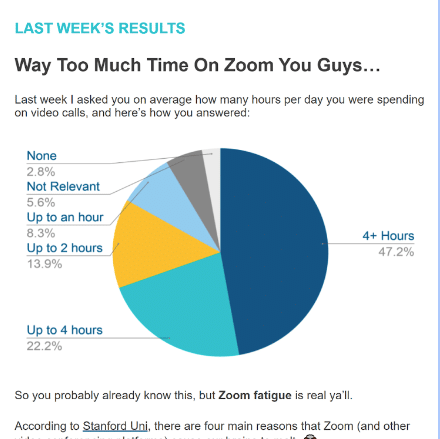
This worked because the polls were relevant to his digital tech audience. Besides, it’s not just a “poll and run” situation. He turned each result into a mini-blog with further insights.
You too could poll your readers or ask them for feedback as a marketing strategy.
You could also feature individual subscribers in your newsletter.
For example, The Idea ran a subscriber spotlight feature in its newsletter. It took the form of a Q&A with one of their subscribers.
There’s more than one way to make subscribers feel special. Another is to roll out the virtual red carpet when new subscribers join.
2. Welcome sequence
Who doesn’t like to feel welcomed when they enter a space? Whether it’s your local coffee shop or a newsletter, feeling included will encourage you to stay.
And, if you want to reduce customer churn and stop losing customers, making your reader feel cozy is essential.
Welcome emails receive twice as many clicks and opens as other email campaigns. This great opportunity is all too often wasted, with only 39% of brands sending one.
This is why creators like Harry Dry of marketingexamples.com use welcome sequences.
Dry’s approach to the welcome sequence is simple: share his five most popular case studies. This way, the subscriber feels caught up, gets maximum value straight out of the gate, and is less likely to hit “unsubscribe”.
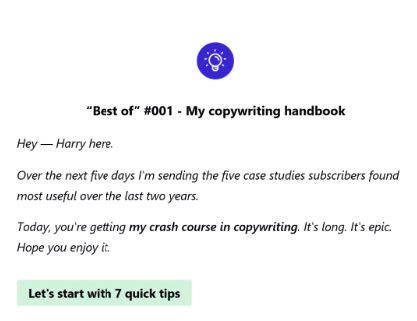
Even if your newsletter is too new to have an extensive archive to pick from, you can still create a small welcome sequence.
Thank your subscribers for joining by sending them free and relevant resources (either created by you or others).
Alternatively, use the sequence to introduce yourself and the work you do.
That covers when and how to make your audience feel welcome, but that still begs the question of how to manage welcoming them. For that, you need our next section.
Build your newsletter
You’ve got a brilliant newsletter idea you know your audience will love. The last thing you want to stress about is technology.
The process of scheduling and sending needs to be as straightforward and painless as possible. Otherwise, you’ll quickly feel discouraged and frustrated.
At the same time, you need your email service provider to have some sophistication.
Some “great to have” features include: landing pages, segmented audiences, signup forms, email metrics (your click and open rate), and the ability to lead a drip campaign.
Here are just a few email marketing tools that can support your newsletter:
- Mailchimp
- Brevo (ex: Sendinblue)
- Sendfox
- Mailerlite
Your CRM might also have its own in-built email newsletter system, such as Hubspot.
Finally, don’t let email newsletter design be the thing that stops you from getting started. Minimalist design works great. Clean text-based emails result in 21% higher CTOR and 17% CTR than HTML emails they provide a better user experience. They also increase the deliverability of your emails.
Keep growing your business with an addictive B2B newsletter
Email newsletters are a powerful tool for B2B businesses and can help them get to the next level.
To recap, here’s how you can create a newsletter people look forward to opening:
- Decide if your newsletter will be helpful, funny, inspiring, or a mixture of these.
- Know what your audience wants — research their questions on Reddit or poll your existing customers.
- Keep them wanting more by involving them in your newsletter.
- Create a welcome sequence for new subscribers.
Ultimately, the difference between a successful newsletter and one languishing in the spam folder is purpose. Find the sweet spot between your business interests and their needs, and your audience will keep coming back for more.
Want us to help you accelerate the path to a powerful B2B newsletter? Get in touch at hello@isolinecomms.com
